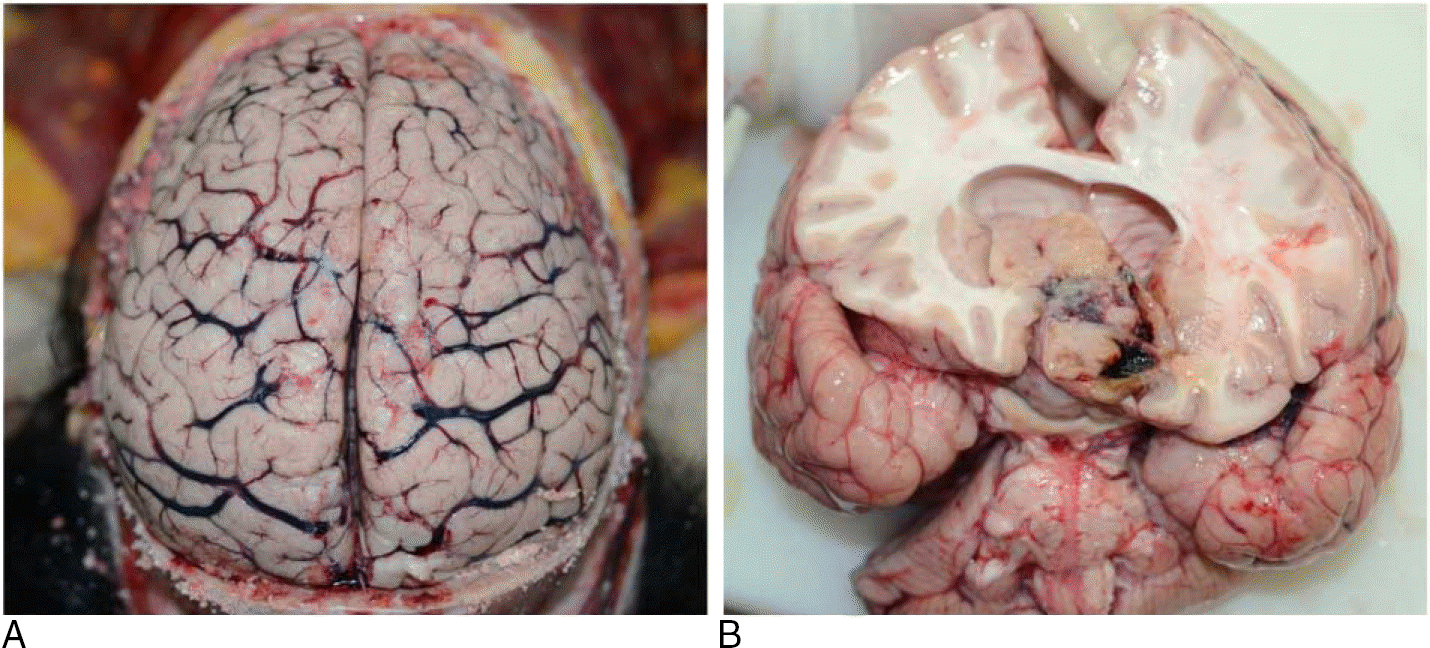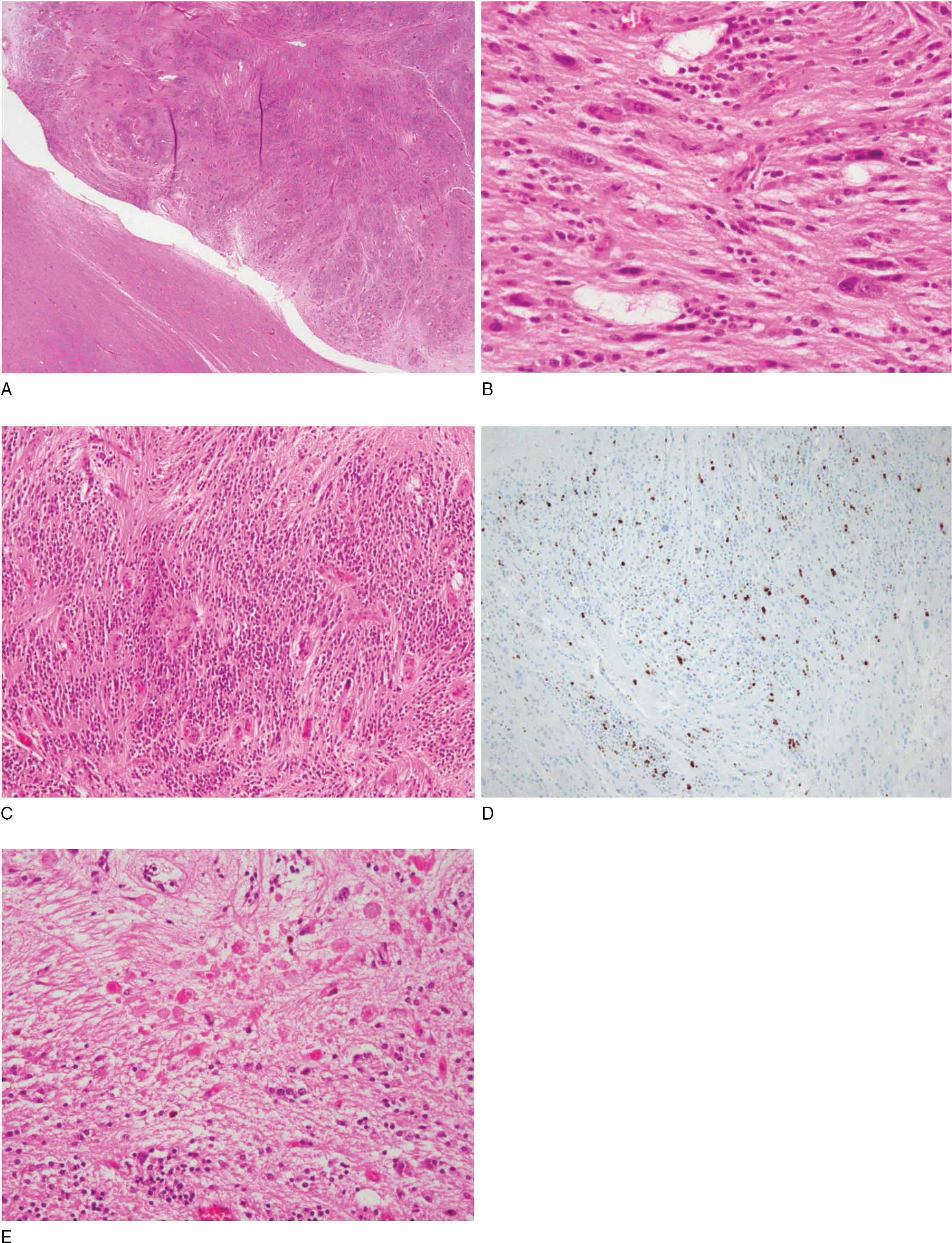Abstract
Intracranial neoplasms usually have definitive symptoms, causing a need for medical intervention, but a few cases result in sudden unexpected death even before diagnosis. In these cases, autopsy or postmortem imaging may be the only way of identifying the existence of a tumor, so investigators or forensic specialists who participate in the postmortem inspection should be aware of these possibilities. We report on a case of a 26-year-old woman without any medical history found dead in her home. A 5-cm intraventricular tumor was found during autopsy, which was histologically consistent with anaplastic ganglioglioma a very rare type of neuroglial tumor with the potential for malignant behavior. The tumor showed the characteristic features of anaplastic ganglioglioma, such as increased cellularity, a high Ki-67 proliferative index, and necrosis. There were signs of increased intracranial pressure, including flattened gyri and dilated ventricles, which led to the conclusion that this brain tumor was the cause of death.
Go to : 
REFERENCES
1. Vougiouklakis T, Mitselou A, Agnantis NJ. Sudden death due to primary intracranial neoplasms: a forensic autopsy study. Anticancer Res. 2006; 26:2463–6.
2. Selvanathan SK, Hammouche S, Salminen HJ, et al. Outcome and prognostic features in anaplastic ganglioglioma: analysis of cases from the SEER database. J Neurooncol. 2011; 105:539–45.

3. DiMaio SM, DiMaio VJ, Kirkpatrick JB. Sudden, unexpected deaths due to primary intracranial neoplasms. Am J Forensic Med Pathol. 1980; 1:29–45.

4. Elgamal EA, Richards PG. Sudden death in children due to intracranial mass lesion. Childs Nerv Syst. 2006; 22:305–9.

5. Eberhart CG, Morrison A, Gyure KA, et al. Decreasing incidence of sudden death due to undiagnosed primary central nervous system tumors. Arch Pathol Lab Med. 2001; 125:1024–30.

6. Matschke J, Tsokos M. Sudden unexpected death due to undiagnosed glioblastoma: report of three cases and review of the literature. Int J Legal Med. 2005; 119:280–4.
7. Huh GY, Kim KH, Ahn YW, et al. Sudden death due to undiagnosed intracranial meningioma: a case report. Korean J Leg Med. 2008; 32:150–2.
8. Kim KH, Ahn YW, Jo GR, et al. Sudden death due to a ganglioglioma. Korean J Leg Med. 2009; 33:126–9.
9. Kim SH, Kim TG, Seo IS, et al. Sudden unexpected death due to medulloblastoma. Korean J Leg Med. 2009; 33:130–2.
Go to : 
 | Fig. 1.(A) Flattened gyri of the cerebral cortex are observed, implying increased intracranial pressure. (B) The tumor was located in the right lateral and third ventricle, resulting in ventricular dilation. The cut surface of the tumor shows focal hemorrhage and necrosis. |
 | Fig. 2.(A) Microscopic image showing the tumor border with a relatively distinct demarcation but without encapsulation. (B) Large multinucleated ganglion cells can be seen admixed with glial cells in the neutrophilic background. The ganglion cells show prominent nucleoli and abundant eosinophilic cytoplasm. Anaplastic changes can be observed, such as increased cellularity (C), a high Ki-67 proliferative index (D), and necrosis (E) in multifocal areas (A, H&E, 12.5; B, H&E, 200; C, H&E, 100; D, Ki-67, 100; E, H&E, 200). |
Table 1.
Summarized cases of sudden unexpected death due to intracranial neoplasm reported in Korea for the past 10 years




 PDF
PDF ePub
ePub Citation
Citation Print
Print


 XML Download
XML Download